 The Lear Siegler ADM-3A is a very popular early "dumb" terminals. Internally it does not
have a microprocessor, just a board full of TTL logic.
The Lear Siegler ADM-3A is a very popular early "dumb" terminals. Internally it does not
have a microprocessor, just a board full of TTL logic.Terminals are computer displays which interface via a serial connection (usually RS-232). Most modern computers use integrated keyboards and graphic video screens, however in the early days of computing, nearly all mainframe computers and many personal computers used text mode terminals connected via a console serial port.
Click any photo to view a large high-resolution image.
 The Lear Siegler ADM-3A is a very popular early "dumb" terminals. Internally it does not
have a microprocessor, just a board full of TTL logic.
The Lear Siegler ADM-3A is a very popular early "dumb" terminals. Internally it does not
have a microprocessor, just a board full of TTL logic.
This terminal is covered in detail in my Altair page.
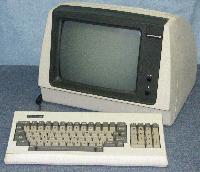 This is another Lear Siegler terminal called the ADM-20 - this terminal was
usually sold as an OEM system under another name.
This is another Lear Siegler terminal called the ADM-20 - this terminal was
usually sold as an OEM system under another name.
The one displayed is badged with a "Morrow Designs" label, and was distributed as part of their Micro-Decision computer system.
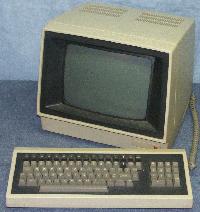 Here is a Morrow MDT-60 terminal, which was manufactured by Morrow Designs,
and was also distributed with some Micro-Decision
systems.
Here is a Morrow MDT-60 terminal, which was manufactured by Morrow Designs,
and was also distributed with some Micro-Decision
systems.
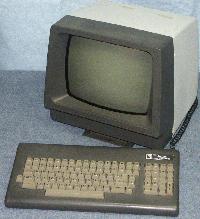 This is a Liberty Electronics Freedom-100 terminal, which is quite useful in
that it can emulate several other terminal types.
This is a Liberty Electronics Freedom-100 terminal, which is quite useful in
that it can emulate several other terminal types.
Another unique feature is the adjustable "leg" on the front which allows you to tilt the terminal upward at one of several angles.
This terminal was also often distributed as an OEM device - Another Freedom-100 in the collection has a slightly different keyboard with a Morrow Designs logo..
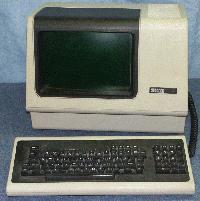 The Digital Equipment Corp. VT-100 is a very popular terminal, which features
advanced capabilities such as smooth-scroll, programmable scrolling region,
double-height and double width charcters, display attributes and many other
features. This terminal is widely cloned, and became the basis of the ANSI
standard.
The Digital Equipment Corp. VT-100 is a very popular terminal, which features
advanced capabilities such as smooth-scroll, programmable scrolling region,
double-height and double width charcters, display attributes and many other
features. This terminal is widely cloned, and became the basis of the ANSI
standard.
An optional Z80 board can be added to a VT-100 to turn it into a VT-180 computer which runs CP/M.
Here is a PC based VT-100 Emulator.
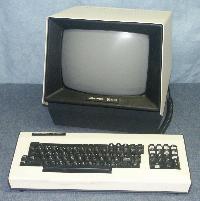 This Datamedia DT80 terminal brings back memories of many 100s of hours spent
in front of one of these during one phase in my career (connected to a VAX785).
It is one of the best clones of the Digital Equipment Corp. VT-100 terminal
that I have seen. All of the setup menus function exactly the same as the
VT-100 (I use a VT-100 manual as a reference), and I have never seen any
incompatibility with any software.
This Datamedia DT80 terminal brings back memories of many 100s of hours spent
in front of one of these during one phase in my career (connected to a VAX785).
It is one of the best clones of the Digital Equipment Corp. VT-100 terminal
that I have seen. All of the setup menus function exactly the same as the
VT-100 (I use a VT-100 manual as a reference), and I have never seen any
incompatibility with any software.
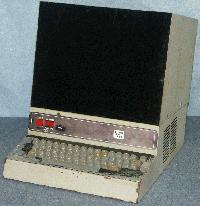 The Volker-Craig VC303 is a very early Canadian made "dumb" terminal which
does not utilize a microprocessor. Due to it's primitive design, it has some
odd characteristics, such as the fact that it can only scroll two lines at a
time.
The Volker-Craig VC303 is a very early Canadian made "dumb" terminal which
does not utilize a microprocessor. Due to it's primitive design, it has some
odd characteristics, such as the fact that it can only scroll two lines at a
time.
Here is a view from the back.
Donated by Markus Wandel.
Documents: Service Manual (1.3M PDF).
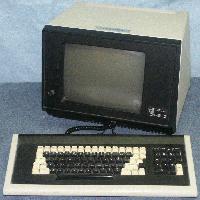 The Volker-Craig VC4404 is a later Canadian terminal. I've used this one a
great deal, and it's quite nice and fast. It features ADM-3A emulation, as
well as it's own "404" mode.
The Volker-Craig VC4404 is a later Canadian terminal. I've used this one a
great deal, and it's quite nice and fast. It features ADM-3A emulation, as
well as it's own "404" mode.
One annoying feature of this terminal is that it does not have a hardware cursor - it displays the cursor by alternating a "cursor character" (either block or underline) with the character in the cursor position - this causes the character to flash when an underline cursor is used, which is why VC4404s are almost always configured to a block cursor.
Donated by Mike Kenzie.
Documents: User Manual (600k PDF), Service Manual (900k PDF), Schematics (750k PDF).
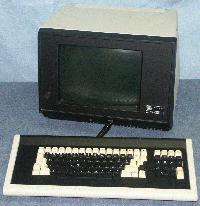 The Volker-Craig VC3100 is a Canadian ANSI terminal which emulates most of
the VT-100 features. This is one of the slowest terminals I have ever used,
and cannot display data at speeds above 2400 bps without the use of flow
control.
The Volker-Craig VC3100 is a Canadian ANSI terminal which emulates most of
the VT-100 features. This is one of the slowest terminals I have ever used,
and cannot display data at speeds above 2400 bps without the use of flow
control.
When NABU bought Volker-Craig, the VC3100 was rebadged as NABU3100 and was used as the standard terminal with the Nabu 1600 system.
Donated by Markus Wandel.
Documents: User Manual (1.5M PDF), Service Manual (1.8M PDF), Schematics (4.2M PDF).
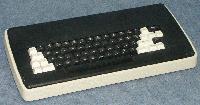 I have found little information about this Volker-Craig "terminal in a keyboard".
The circuit board has been manually trimmed to
fit the case, which suggests that it may be a prototype.
Here is a view from the back.
If you can provide any further information, please contact me.
I have found little information about this Volker-Craig "terminal in a keyboard".
The circuit board has been manually trimmed to
fit the case, which suggests that it may be a prototype.
Here is a view from the back.
If you can provide any further information, please contact me.
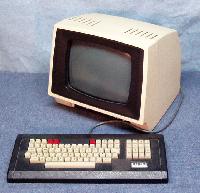 Here is another Canadian built terminal, by Cybernex Corp.
Here is another Canadian built terminal, by Cybernex Corp.
I once owned an older Cybernex terminal which I used with my Altair system.
 This SouthWest Technical Products C-64 is a very early terminal commonly used
on S-100 systems. It originally had a matching composite monitor, however this
was not acquired with the terminal. Here is a view from the
back, and a look
inside.
This SouthWest Technical Products C-64 is a very early terminal commonly used
on S-100 systems. It originally had a matching composite monitor, however this
was not acquired with the terminal. Here is a view from the
back, and a look
inside.
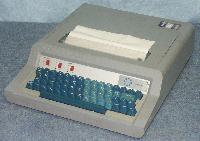 This Computer Devices Miniterm 1203 is an example of a portable printing
terminal from the 1970's. It uses an acoustic coupler - the telephone handset
fits into rubber cups on the back of the machine.
Here it is with the cover on.
This Computer Devices Miniterm 1203 is an example of a portable printing
terminal from the 1970's. It uses an acoustic coupler - the telephone handset
fits into rubber cups on the back of the machine.
Here it is with the cover on.
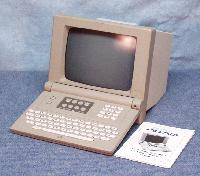 This is an AlexTerm, a terminal dedicated to an information service that was once
offered by Bell Canada.
This is an AlexTerm, a terminal dedicated to an information service that was once
offered by Bell Canada.